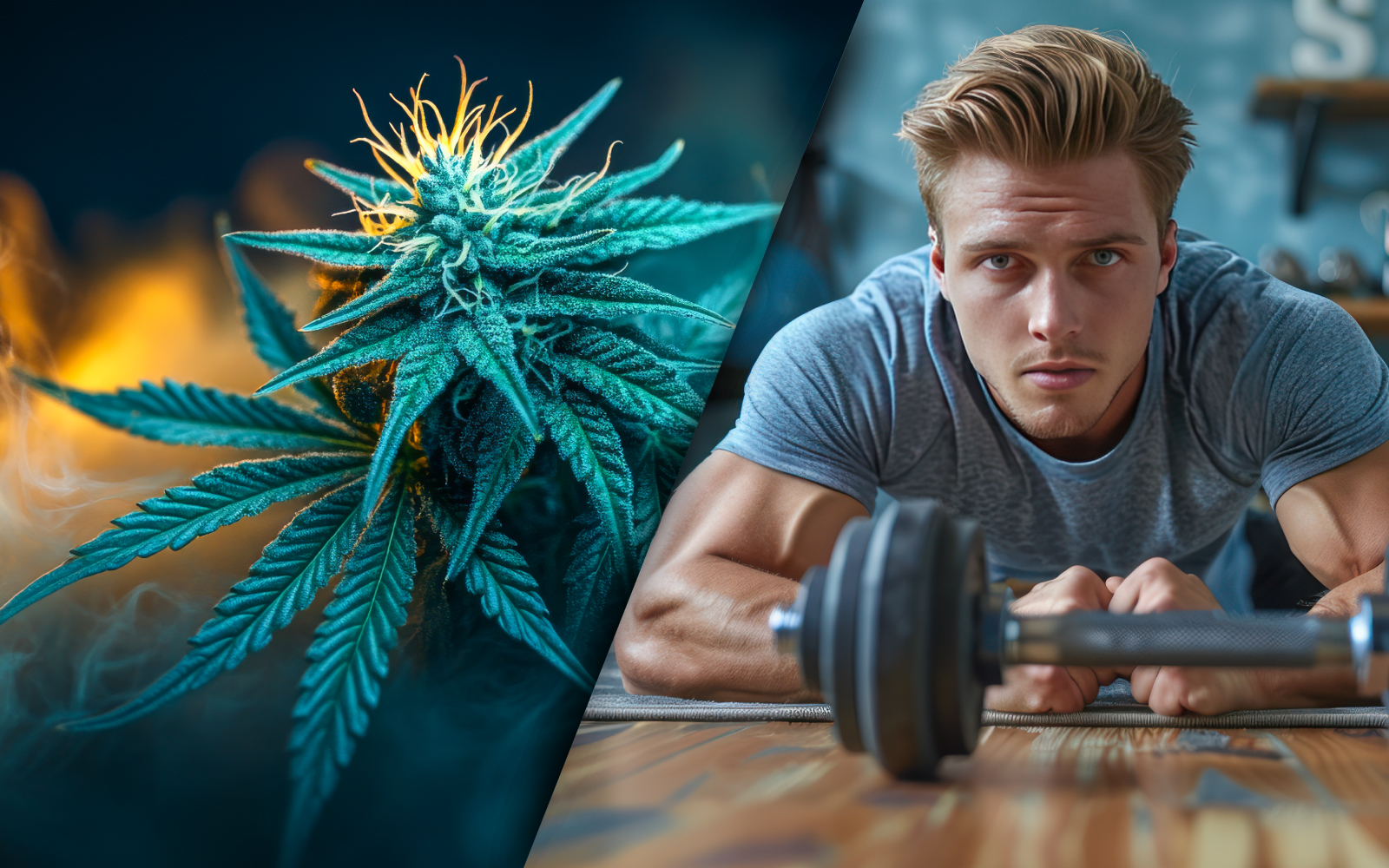Cannabis has slowly lost its old-fashioned bad reputation over the past few years and become a part of wellness habits all over the world. There is study going on with the plant to find out how it can help many different health issues. But a lot of people want to know: Can cannabis help you work out?
Some folks might not understand why you would want to work out and smoke weed at the same time. Weed users often feel sleepy and tired, which means they can’t do squats or runs. More and more athletes and people who work out, though, swear by it. They say it keeps them inspired, helps them focus, repairs them faster, and even makes them stronger.
What does the world of science say about this pattern? What matters most is whether it is right or safe for you.
The Cannabis-Fitness Connection: A Changing Perspective
The intersection of cannabis and athleticism is not as new as it seems. Historical records suggest that ancient cultures may have used cannabis to relieve pain and aid recovery after physical labor. However, in modern times, as fitness culture exploded and cannabis remained largely criminalized, the two worlds seemed at odds. That’s changing fast.
With legalization spreading across North America and beyond, both recreational users and professional athletes are increasingly open about integrating cannabis into their fitness routines. In fact, the World Anti-Doping Agency (WADA) removed CBD (a non-psychoactive compound in cannabis) from its list of banned substances in 2018, prompting further mainstream acceptance.
How Cannabis Affects the Body
Before diving into its potential fitness benefits, let’s explore how cannabis interacts with the body.
Cannabis contains over 100 cannabinoids, the most well-known being:
- THC (Tetrahydrocannabinol): The psychoactive component that causes the “high.”
- CBD (Cannabidiol): Non-psychoactive and widely used for its anti-inflammatory and calming effects.
These compounds interact with the endocannabinoid system (ECS), a regulatory network in our bodies that influences pain perception, mood, appetite, immune function, and more.
When cannabis is consumed-via smoking, vaping, edibles, tinctures, or topicals-it interacts with cannabinoid receptors (CB1 and CB2) throughout the body, triggering a variety of responses.
Potential Benefits of Cannabis for Fitness
- Pain Management
One of the most widely reported benefits of cannabis among athletes is pain relief. Whether it’s the soreness from lifting weights or chronic joint discomfort from long-distance running, cannabis (especially CBD) may help alleviate both acute and long-term pain.
- Improved Recovery
Post-workout recovery is crucial to building strength and endurance. CBD, in particular, has been found to reduce inflammation, which could potentially decrease muscle soreness and speed up recovery time. Some athletes also report better sleep when using cannabis, and since sleep is critical for muscle repair, this could indirectly enhance recovery as well.
- Enhanced Focus and Mind-Muscle Connection
Surprisingly, some strains of cannabis-especially sativa-dominant ones-can increase alertness and mental clarity. Users report a heightened “mind-muscle connection,” where they feel more in tune with their bodies during workouts, particularly in practices like yoga or bodybuilding. Cannabis may also help users enter a flow state, reducing distractions and increasing enjoyment during long or repetitive activities like cycling or running.
- Stress and Anxiety Reduction
Gym anxiety is real. For beginners, stepping into a fitness center can be intimidating. Even seasoned athletes can face performance anxiety before competitions or PR attempts. Cannabis, especially strains high in CBD or balanced hybrids, can ease these anxious feelings and promote a calm, focused mindset.
- Increased Enjoyment of Exercise
Let’s face it-not everyone loves working out. For some, cannabis makes the process more enjoyable. Music sounds better, repetitive activities feel more engaging, and the overall experience becomes less of a chore. This increased enjoyment may lead to greater consistency, which is often the biggest predictor of long-term fitness success.
How Athletes Use Cannabis
The way cannabis is integrated into a fitness routine varies widely based on personal preference and goals. Here are a few common approaches:
- Pre-Workout: To enhance focus, motivation, or reduce anxiety.
- Intra-Workout: For endurance sports like long-distance running or hiking.
- Post-Workout: For pain relief, relaxation, or better sleep.
Popular Forms for Fitness Use:
- CBD oils or tinctures: For inflammation and recovery.
- Topical creams: Targeted relief for sore muscles or joints.
- Vaping or smoking: Fast-acting relief, though not ideal for lung health.
- Edibles: Long-lasting effects, good for post-workout relaxation.
Potential Downsides and Considerations
While many report positive effects, cannabis and exercise are not a one-size-fits-all solution. There are several factors to consider before incorporating it into your fitness regimen.
- Impaired Coordination and Judgment
THC can impair motor function, balance, and reaction time. This can increase the risk of injury, especially in high-intensity or complex movements like Olympic lifts or team sports. If you’re using cannabis before workouts, especially THC-rich products, stick to safer and more controlled exercises.
- Increased Heart Rate
Cannabis can cause a temporary spike in heart rate, which might not be suitable for people with cardiovascular issues or those doing intense cardio. Always consult a doctor if you have underlying health concerns. - Tolerance and Dependency
Frequent use of cannabis, especially THC, can lead to tolerance-meaning you need more to achieve the same effect. In some cases, psychological dependency can develop. Balance is key. Consider limiting use to specific goals like recovery or mental clarity, rather than making it a daily habit.
- Legal and Workplace Implications
Even where cannabis is legal, workplace policies or athletic organizations may prohibit its use. Athletes should always verify whether cannabis use aligns with their professional guidelines.
Tips for Safely Incorporating Cannabis Into Your Routine
If you’re curious about trying cannabis as part of your fitness lifestyle, here are some guidelines to follow:
- Start Low and Go Slow: Especially if you’re new, begin with low doses of THC or CBD and monitor how your body responds.
- Choose the Right Strain: Sativas for energy and focus, indicas for relaxation and recovery, hybrids for balance.
- Pick the Right Timing: Use it before low-risk activities (like yoga, walking, or stretching) and save intense workouts for sober days.
- Stay Hydrated: Cannabis can cause dry mouth, and hydration is essential for workouts.
- Know the Law: Make sure you’re complying with local regulations and any applicable sports rules.
Conclusion
Cannabis isn’t a magic pill, nor is it for everyone. But for many people, it offers unique benefits that can enhance various aspects of a fitness routine-from mental focus and enjoyment to pain relief and recovery.
As research evolves and social attitudes shift, the role of cannabis in sports and fitness will likely continue to expand. If approached responsibly and mindfully, cannabis might just become another tool in your wellness toolbox.
Ultimately, the best fitness routine is the one you’ll stick to-and if cannabis helps you stay consistent, recover better, or enjoy the process more, it could be worth exploring.








